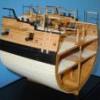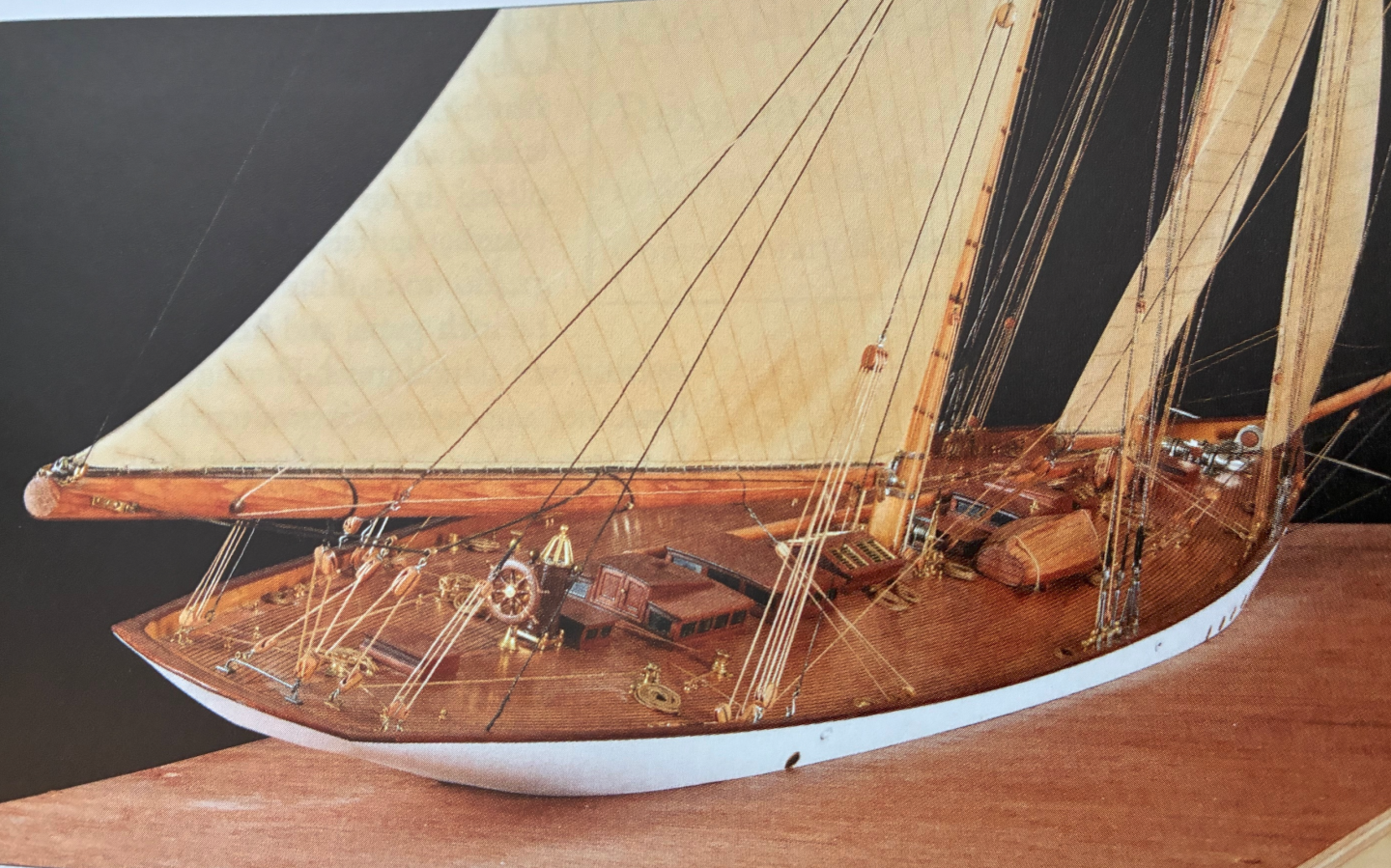
sob
Members-
Posts
93 -
Joined
-
Last visited
Recent Profile Visitors
-
see, for example https://landandseacollection.com/id267.html also from https://www.busaccagallery.com/gallery_view.php?id=6292&page=video "McKay had learned his lessons well in the construction of water-line half-hull models from the master, Orlando B. Merrill, from his earlier days at Newburyport. Once he was satisfied with his workmanship, he removed the dowels and the rectangular slices of wood, known as "lifts," and one by one transferred the lines of each "layer" of the hull to graph paper called a "sheer plan" by maritime architects. The scale ratio translated out to one quarter of an inch for each foot of the ship, 48 times the original length of the lines. The lines were now ready to be transferred to McKay's huge mold loft that was the size of a ship. It was here that a full side of the Flying Cloud was charted in chalk with a different color of chalk used for each lift layer. The shape of each lift edge's chalkline on the mold loft floor showed the exact water lines of the hull at various depths. With his keen attentive mind and trained eye, Donald McKay had no trouble visualizing his one dimensional colored chalk lines of the Flying Cloud's three-dimensional hull." many other references
-
re: "Crothers' statement that decks were kept level " he actually said that the deck rose at a slower rate than the planksheer - not that it was flat if it were flat the would be close to 3 feet of extra space at the forecastle - my plotting of the sheer against the deck & planksheer came up with around bit more than 2 feet of extra height which worked out to enough without a lower floor but a lowered floor would have made things far more comfortable Scott
-
 ClipperFan reacted to a post in a topic:
Staghound 1850 by rwiederrich - 1/96 - Extreme Clipper
ClipperFan reacted to a post in a topic:
Staghound 1850 by rwiederrich - 1/96 - Extreme Clipper
-
we are after the same thing - historical accuracy - but that is, in reality, unobtainable since the records do not exist - all we can do is to do our best and that may mean that we do not all agree on every detail among other things you have concluded that there was a step down under the forecastle - based on Crothers I do not think that was needed you have concluded the the windless was huge and under the forecastle - that is an uncommon view and with so many sources saying that the windlass in that time period was generally aft of the forecastle I tend to the other view you have concluded that the structure on the glory (that looks like a headboard) had a purpose far more than to just looking good - I have no reason to think otherwise and do not have an opinion on the topic but you extend that conclusion across the entire McKay line of clippers and I see insufficient support for that extension I will be updating my drawing based on our discussions but not likely to your satisfaction I'm not sure there is more to be said that would convince me or you of the correctness of the other's ways so maybe its time to let it go as it is and focus on what we agree on unless more information comes up to settle the questions Scott
-
note - excerpt from Crothers I posted a while ago says that the sheer of the deck did not follow the sheer of (for example) the main rail - in fact the distance from the deck to the main rail grew as you got closer to the bow thus giving additional headroom under the forecastle without the need to have a step down
-
 ClipperFan reacted to a post in a topic:
Staghound 1850 by rwiederrich - 1/96 - Extreme Clipper
ClipperFan reacted to a post in a topic:
Staghound 1850 by rwiederrich - 1/96 - Extreme Clipper
-
here is what he said in his manuscript - he later tracked down the original Captains of ships operating in the China trade often commissioned a Chinese artist to paint their ship while it lay in Hong Kong or another Chinese port. It was the practice of these Chinese artists to go on board and actually measure the various features of the ship, after which they would return to their canvas and meticulously lay out the ship as a sheer or broadside plan. They painted using these lines as the skeleton. Because they were for the Captain, and because actual measurements were taken, paintings of this type were considered to very accurately represent a ship. The Peabody Museum has in its files a very small (3” x 5"), stained photograph of one such painting which is labeled as the Flying Cloud. "Old Ships of New England" reproduces the same painting, but it appears to be simply a photograph of the Peabody photograph. However, there is some question of this being in fact a painting of the Flying Cloud since the steve of the bowsprit is 5½ inches versus 4 inches shown on the MIT plan and in the Currier lithograph. At tempts to locate the original painting have failed, but careful examination of the original photograph under a microscope did not disclose the name of the ship. The assumption has been made that this painting was actually of the Flying Cloud and it has been used to a considerable extent in this study.
About us
Modelshipworld - Advancing Ship Modeling through Research
SSL Secured
Your security is important for us so this Website is SSL-Secured
NRG Mailing Address
Nautical Research Guild
237 South Lincoln Street
Westmont IL, 60559-1917
Model Ship World ® and the MSW logo are Registered Trademarks, and belong to the Nautical Research Guild (United States Patent and Trademark Office: No. 6,929,264 & No. 6,929,274, registered Dec. 20, 2022)
Helpful Links
About the NRG
If you enjoy building ship models that are historically accurate as well as beautiful, then The Nautical Research Guild (NRG) is just right for you.
The Guild is a non-profit educational organization whose mission is to “Advance Ship Modeling Through Research”. We provide support to our members in their efforts to raise the quality of their model ships.
The Nautical Research Guild has published our world-renowned quarterly magazine, The Nautical Research Journal, since 1955. The pages of the Journal are full of articles by accomplished ship modelers who show you how they create those exquisite details on their models, and by maritime historians who show you the correct details to build. The Journal is available in both print and digital editions. Go to the NRG web site (www.thenrg.org) to download a complimentary digital copy of the Journal. The NRG also publishes plan sets, books and compilations of back issues of the Journal and the former Ships in Scale and Model Ship Builder magazines.




